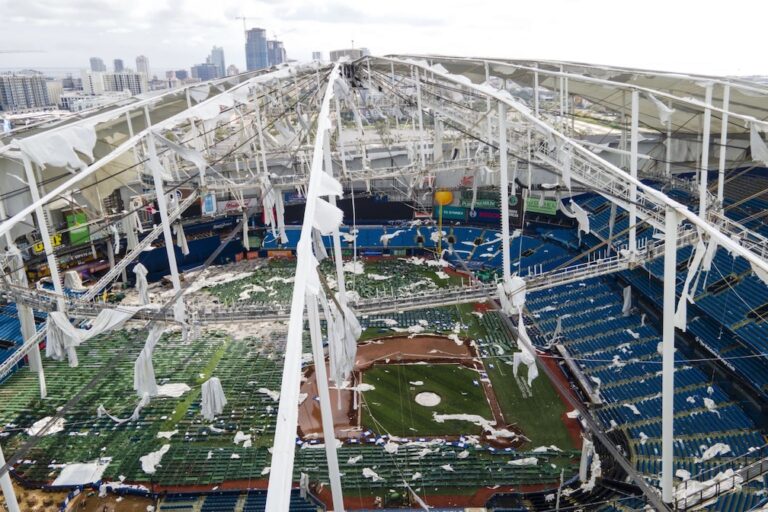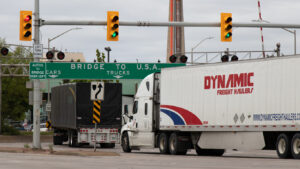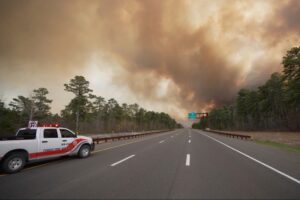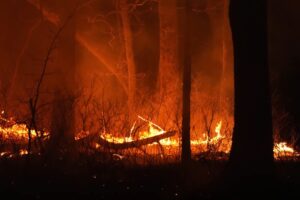TAMPA, Fla. (AP) — Hurricane Milton barreled into the Atlantic Ocean on Thursday after plowing across Florida, where it knocked out power to more than 3 million customers and whipped up 150 tornadoes. The storm caused at least four deaths and compounded the misery wrought by Helene while sparing Tampa a direct hit.
The system tracked to the south in the final hours and made landfall late Wednesday as a Category 3 storm in Siesta Key, about 70 miles (112 kilometers) south of Tampa. Damage was widespread, and water levels may continue to rise for days, but Gov. Ron DeSantis said it was not “the worst-case scenario.”
The deadly storm surge feared for Tampa never materialized, though the storm dumped up to 18 inches (45 centimeters) of rain in some areas, the governor said. The worst storm surge appeared to be in Sarasota County, where it was 8 to 10 feet (2.5 to 3 meters) — lower than in the worst place during Helene.
“We will better understand the extent of the damage as the day progresses,” DeSantis said. “We’ve got more to do, but we will absolutely get through this.”
As dawn broke Thursday, storm-surge warnings were still posted for much of the east-central Florida coast and north into Georgia. Tropical storm warnings were in place along the coast into South Carolina. Officials in the hard-hit Florida counties of Hillsborough, Pinellas, Sarasota and Lee urged people to stay home, warning of downed power lines, trees in roads, blocked bridges and flooding.
“We’ll let you know when it’s safe to come out,” Sheriff Chad Chronister of Hillsborough County, home to Tampa, said on Facebook.
Just inland from Tampa, the flooding in Plant City was “absolutely staggering,” according to City Manager Bill McDaniel. Emergency crews rescued 35 people overnight, said McDaniel, who estimated the city received 13.5 inches (34 cm) of rain.
“We have flooding in places and to levels that I’ve never seen, and I’ve lived in this community for my entire life,” he said in a video posted online Thursday morning.
The tiny barrier island of Matlacha, just off Fort Myers, got hit by both a tornado and a surge, with many of the colorful buildings in the fishing and tourist village sustaining serious damage. Tom Reynolds, 90, spent the morning sweeping out four feet of mud and water and collecting chunks of aluminum siding torn off by a twister that also picked up a car and threw it across the road.
Elsewhere on the island, a house was blown into a street, temporarily blocking it. Some structures caught fire. Reynolds said he planned to repair the home he built three decades ago.
“What else am I going to do?” he said.
In contrast, city workers on Anna Maria Island were grateful not to be wading through floodwaters as they picked up debris Thursday morning, two weeks after Helene battered buildings and blew in piles of sand up to 6 feet (1.8 m) high. Those piles may have helped shield homes from further damage, said Jeremi Roberts of the State Emergency Response Team.
“I’m shocked it’s not more,” city worker Kati Sands said as she cleared the streets of siding and broken lights. “We lost so much with Helene, there wasn’t much left.”
The storm knocked out power across a large section of Florida, with more than 3.4 million homes and businesses without electricity, according to poweroutage.us, which tracks utility reports.
The fabric that serves as the roof of Tropicana Field — home of the Tampa Bay Rays baseball team in St. Petersburg — was ripped to shreds by fierce winds. Debris littered the field, but no injuries were reported. Before the storm hit, first responders were moved from a staging area there.
St. Petersburg residents could no longer get water from their household taps because a water main break led the city to shut down service. Mayor Ken Welch had told residents to expect long power outages and the possible shutdown of the sewer system.
State officials said they completed more than 40 rescues overnight and crews would be going door to door in some areas Thursday. In Tampa, police said they rescued 15 people from a single-story home damaged by a fallen tree.
“We are laser-focused on search-and-rescue operations today,” said Col. Mark Thieme, executive director of the Florida State Guard.
Among the scores of tornadoes, one twister touched down in the lightly populated Everglades and crossed Interstate 75. Another apparent tornado hit in Fort Myers, snapping tree limbs and tearing a gas station’s canopy to shreds.
The Spanish Lakes Country Club near Fort Pierce, on Florida’s Atlantic Coast, was hit particularly hard, with homes destroyed and at least four people killed in tornadoes, the St. Lucie County Sheriff’s Office said.
About 90 minutes after making landfall, Milton was downgraded to a Category 2 storm. By early Thursday, the hurricane was a Category 1 storm with maximum sustained winds of about 85 mph (135 kph) and leaving the state near Cape Canaveral.
The storm slammed into a region still reeling two weeks after Hurricane Helene flooded streets and homes in western Florida and left at least 230 people dead across the South. In many places along the coast, municipalities raced to collect and dispose of debris before Milton’s winds and storm surge could toss it around and compound any damage.
Officials had issued dire warnings to flee or face grim odds of survival.
Jackie Curnick said she wrestled with her decision to stay at home in Sarasota, just north of where the storm made landfall. She and her husband started packing Monday to evacuate, but they struggled to find available hotel rooms, and the few they came by were too expensive.
With a 2-year-old son and a baby girl due Oct. 29, Curnick said there were too many unanswered questions if they got in the car and left: Where would they sleep? Would they be able to fill their gas tank? And could they even find a safe route out of the state?
“The thing is it’s so difficult to evacuate in a peninsula,” she said ahead of the storm. “In most other states, you can go in any direction to get out. In Florida, there are only so many roads that take you north or south.”
Video taken during the storm showed howling winds and sheets of rain lashing their glass-enclosed swimming pool as their son and dog watched. Trees shook violently.
On Thursday morning, she reported that the family was without power but safe.
About 80,000 people spent the night in shelters and thousands of others fled after authorities issued mandatory evacuation orders across 15 Florida counties with a total population of about 7.2 million people.
In Orlando, Walt Disney World, Universal Orlando and Sea World remained closed Thursday. The Tampa airport, which took minimal damage, was expected to reopen no later than Friday, DeSantis said.
Crossing the bridge from the mainland to Anna Maria Island early Thursday, Police Chief John Cosby breathed a sigh of relief. Nearly all residents had evacuated, there were no injuries or deaths and the projected storm surge never happened. After fearing that his police department would be under water, it remained dry.
“It’s nice to have a place to come back to,” he said.
Associated Press journalists Holly Ramer in New Hampshire; Joseph Frederick in West Bradenton, Florida; Curt Anderson in Tampa; Freida Frisaro in Fort Lauderdale; Brenden Farrington in Tallahassee; Michael Goldberg in Minneapolis; Patrick Whittle in Portland, Maine; Jeff Martin in Atlanta and Christopher L. Keller in Albuquerque, New Mexico, contributed to this report.
The Associated Press is an independent global news organization dedicated to factual reporting. Founded in 1846, AP today remains the most trusted source of fast, accurate, unbiased news in all formats and the essential provider of the technology and services vital to the news business. The Trucker Media Group is subscriber of The Associated Press has been granted the license to use this content on TheTrucker.com and The Trucker newspaper in accordance with its Content License Agreement with The Associated Press.







